
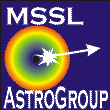
MSSL Astrophysics Group Beginner's Guides
Quasar Tour

The images shown here are simulations of the inner regions of a quasar nucleus, based upon the most popular and/or successful models.
GIF animations illustrating the structure of a quasar nucleus are now available!
Fly through the stars of a distant galaxy and into the heart of the quasar within, with this computer simulation of the quasar tour (183kb)
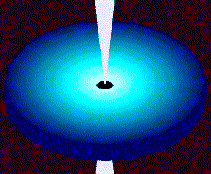 At
the very heart of a quasar lies a supermassive black hole, about a thousand,
million times more massive than our Sun. The gravitational field around
a black hole is so strong that even light cannot escape, if it falls within
the `event horizon'. Surrounding the black hole is an `accretion disc'
(shown blue); a plate-shaped region of gas, which spirals inwards and fuels
the `monster' at the centre. Hurled away from the plane of the disc are
jets of matter (shown white), moving at velocities close to the speed of
light. This region is typically a few light-days across, several times
the size of our Solar System. Take a trip around an accretion disc and into the
black hole with the computer animation of the
disc, black hole and jets (229kb).
At
the very heart of a quasar lies a supermassive black hole, about a thousand,
million times more massive than our Sun. The gravitational field around
a black hole is so strong that even light cannot escape, if it falls within
the `event horizon'. Surrounding the black hole is an `accretion disc'
(shown blue); a plate-shaped region of gas, which spirals inwards and fuels
the `monster' at the centre. Hurled away from the plane of the disc are
jets of matter (shown white), moving at velocities close to the speed of
light. This region is typically a few light-days across, several times
the size of our Solar System. Take a trip around an accretion disc and into the
black hole with the computer animation of the
disc, black hole and jets (229kb).
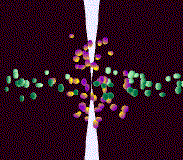 Moving out to about 100 light days and the
accretion disc is now too small to see, although the jets may still be
visible (in some cases, the jets reach distances of hundreds of
thousands of light years across). This is an ensemble of gas clouds
and is known as the `broad line region', because of the spectral lines
which the gas in the clouds emits. There are two parts to the broad
line region; the inner zone (coloured purple/yellow) has a relatively
high density, it's probably spherical and the atoms in the gas have
been stripped of many of their electrons (ie., the gas is `highly
ionized'). The outer zone (shown green) is less dense, the clouds move
more slowly and it's flattened rather than spherical. Here, the atoms
retain more of their electrons, ie. the gas is said to be in a state
of `low-ionization'. Take a look at this computer simulation of a quasar broad line
region (136kB).
Moving out to about 100 light days and the
accretion disc is now too small to see, although the jets may still be
visible (in some cases, the jets reach distances of hundreds of
thousands of light years across). This is an ensemble of gas clouds
and is known as the `broad line region', because of the spectral lines
which the gas in the clouds emits. There are two parts to the broad
line region; the inner zone (coloured purple/yellow) has a relatively
high density, it's probably spherical and the atoms in the gas have
been stripped of many of their electrons (ie., the gas is `highly
ionized'). The outer zone (shown green) is less dense, the clouds move
more slowly and it's flattened rather than spherical. Here, the atoms
retain more of their electrons, ie. the gas is said to be in a state
of `low-ionization'. Take a look at this computer simulation of a quasar broad line
region (136kB).
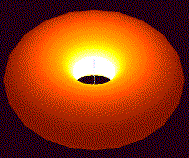 Now
you are looking at a region which is about 100 light years across. This
`doughnut' is made up of many clouds of dusty gas - it is known as the
`molecular torus'. A similar torus has been imaged directly by the Hubble
Space Telescope in the
Seyfert
galaxy NGC4261 and you can see this, and other
AGN images, at the Space
Telescope Science Institute's (STScI) Pictures page.
The torus is `optically thick', ie. light cannot pass through it, so if
the torus is edge-on as we see it, the central regions (the accretion disc,
the region around the black hole and the broad line region) will be blocked
out. This means that AGN will look different according to the angle at
which it lies - this is the principle behind the
Unified
Model of AGN.
Now
you are looking at a region which is about 100 light years across. This
`doughnut' is made up of many clouds of dusty gas - it is known as the
`molecular torus'. A similar torus has been imaged directly by the Hubble
Space Telescope in the
Seyfert
galaxy NGC4261 and you can see this, and other
AGN images, at the Space
Telescope Science Institute's (STScI) Pictures page.
The torus is `optically thick', ie. light cannot pass through it, so if
the torus is edge-on as we see it, the central regions (the accretion disc,
the region around the black hole and the broad line region) will be blocked
out. This means that AGN will look different according to the angle at
which it lies - this is the principle behind the
Unified
Model of AGN.
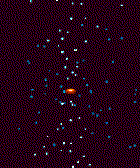 These
are the very outer regions of an active nucleus, before the surrounding
galaxy is reached. The molecular torus can be seen in the centre, surrounded
by small clouds of gas (shown blue). This is the `narrow line region',
which is similar to the broad line region, but it has a lower density and
the clouds move with a lower velocity (so the spectral lines it emits are
narrow). Because of its low density, this gas can produce strong `forbidden'
lines; these are spectral lines which are suppressed in higher density
gas. Notice that the only clouds which are lit up (light blue) are those
which lie in the `cone' of light from the inner nucleus. Clouds that lie
in the shadow of the torus (dark blue) are not lit up. These `ionization
cones' are seen in many nearby galaxies and a good example,
NGC5728
(a caption
for the image is also available), can be seen at STScI. This
computer
simulation of the narrow line region (123kb) will give you another
visualization.
These
are the very outer regions of an active nucleus, before the surrounding
galaxy is reached. The molecular torus can be seen in the centre, surrounded
by small clouds of gas (shown blue). This is the `narrow line region',
which is similar to the broad line region, but it has a lower density and
the clouds move with a lower velocity (so the spectral lines it emits are
narrow). Because of its low density, this gas can produce strong `forbidden'
lines; these are spectral lines which are suppressed in higher density
gas. Notice that the only clouds which are lit up (light blue) are those
which lie in the `cone' of light from the inner nucleus. Clouds that lie
in the shadow of the torus (dark blue) are not lit up. These `ionization
cones' are seen in many nearby galaxies and a good example,
NGC5728
(a caption
for the image is also available), can be seen at STScI. This
computer
simulation of the narrow line region (123kb) will give you another
visualization.
Other Extragalactic Astronomy pages:
Also - why not try the public
pages of the Hubble Space Telescope
for more pictures and information?
 Return to the
MSSL Astrophysics Group Visitor Centre
Return to the
MSSL Astrophysics Group Visitor Centre Mullard Space Science Laboratory
Mullard Space Science Laboratory Back to the
Mullard Space Science Laboratory homepage
Back to the
Mullard Space Science Laboratory homepage